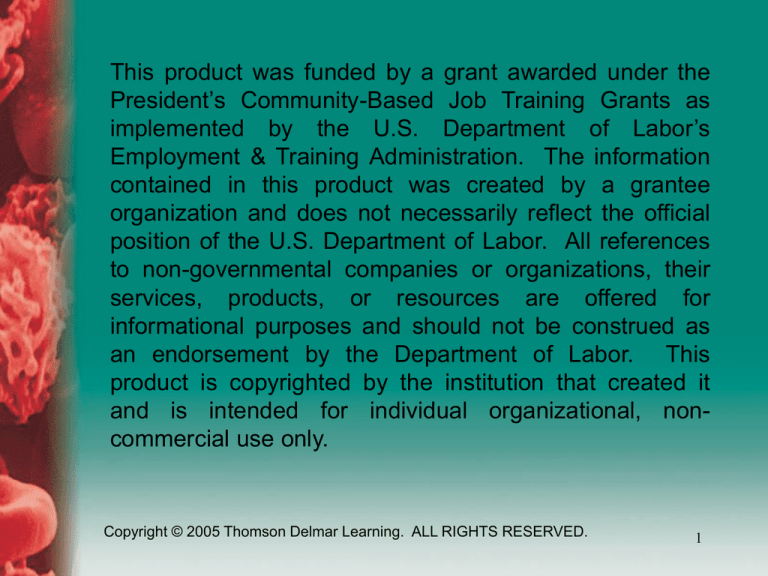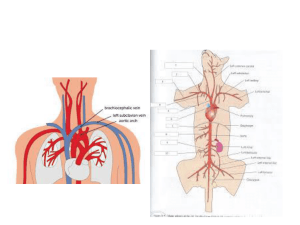
This product was funded by a grant awarded under the
President’s Community-Based Job Training Grants as
implemented by the U.S. Department of Labor’s
Employment & Training Administration. The information
contained in this product was created by a grantee
organization and does not necessarily reflect the official
position of the U.S. Department of Labor. All references
to non-governmental companies or organizations, their
services, products, or resources are offered for
informational purposes and should not be construed as
an endorsement by the Department of Labor. This
product is copyrighted by the institution that created it
and is intended for individual organizational, noncommercial use only.
Copyright © 2005 Thomson Delmar Learning. ALL RIGHTS RESERVED.
1
Test Request Form
• The test request form (requisition) must
contain specific information:
– Patient’s name and age or date of birth
– A UNIQUE patient identification number
– Date and time specimen is to be obtained
– Type of test to be collected
Copyright © 2005 Thomson Delmar Learning. ALL RIGHTS RESERVED.
3
Test Request Form (cont.)
– An accessioning number
– The physician’s name
– The department or location work is to be
done
– Other specific specimen information
– ICD9 diagnosis codes
Copyright © 2005 Thomson Delmar Learning. ALL RIGHTS RESERVED.
4
Minimum Requirements to
Label a Specimen
•
All specimens should be labeled before you leave
the patient. The following is required:
– The patient’s first and last names
– An identification number, such as date of birth
– The collection date
– Time the specimen was collected
– The initials or name of the person collecting
the specimen
Copyright © 2005 Thomson Delmar Learning. ALL RIGHTS RESERVED.
5
Appropriate Venipuncture Site
• The median cubital vein of the
•
antecubital area of the arm is the
preferred vein to use for
venipuncture.
The secondary site for
venipuncture is the top of the
hand.
Copyright © 2005 Thomson Delmar Learning. ALL RIGHTS RESERVED.
6
Sites to Avoid
• Arms with IVs
• Arms with any
•
•
indwelling line
Edematous
arms
Arms in casts
• Cannulas:
Central line, Art line,
Subclavian line,
PICC line, Port-a-Cath,
Hep lock, Saline lock
• Fistulas (dialysis pts)
• Areas of scarring
• Side of a
mastectomy
Copyright © 2005 Thomson Delmar Learning. ALL RIGHTS RESERVED.
7
Order of Draw When Filling
Evacuated Tubes
• Blood culture bottles or yellow top
•
•
blood culture tubes (sterile procedure)
Coagulation tubes (e.g., light blue top)
Serum tube with or without clot
activator or gel serum separator (e.g.,
gold, red top, red/black top, plastic, or
glass)
Copyright © 2005 Thomson Delmar Learning. ALL RIGHTS RESERVED.
8
Order of Draw When Filling
Evacuated Tubes (cont.)
• Heparin tube with or without gel
•
•
separator (e.g., green top)
EDTA tube (e.g., lavender top)
Oxalate/fluoride, glycolytic inhibitor tube
(e.g., gray top)
Copyright © 2005 Thomson Delmar Learning. ALL RIGHTS RESERVED.
9
Order of Draw When Filling
Evacuated Tubes
• If not all the tubes in the order of
draw are to be collected, the order is
started with the first tube needing
collection.
Copyright © 2005 Thomson Delmar Learning. ALL RIGHTS RESERVED.
10
Copyright © 2005 Thomson Delmar Learning. ALL RIGHTS RESERVED.
11
Tubes in the Correct
Order of Draw
•
•
Blood Culture – always first!
If no Blood Cultures, then
1. Light Blue (Citrate) (Coag tests)
2. Serum tubes (no anticoagulant) - can
be red, tiger top, gold (Chemistry
tests, BMP, CMP, lipid, etc.)
3. Green (Heparin) (STAT tests,
ammonia, etc)
4. Lavender (EDTA) (Hematology tests,
CBC, Sed Rate, Hgb & Hct)
5. Gray (Oxalate) (Glucose levels)
Copyright © 2005 Thomson Delmar Learning. ALL RIGHTS RESERVED.
12
Positioning the Patient for
Specimen Collection
• The patient
must be made
to feel at ease.
Copyright © 2005 Thomson Delmar Learning. ALL RIGHTS RESERVED.
13
Steps to Performing a Safe
Venipuncture
• Verify any patient restrictions.
• Assemble supplies.
• Greet patient.
• Positively identify patient
• Tie tourniquet and locate a vein.
Copyright © 2005 Thomson Delmar Learning. ALL RIGHTS RESERVED.
14
Vacutainer, Butterfly, or
Syringe Collection
•
•
•
Apply
tourniquet.
Feel for a
vein.
Clean with
alcohol
swab in
concentric
circles.
Copyright © 2005 Thomson Delmar Learning. ALL RIGHTS RESERVED.
15
If using Vacutainer
•
•
Hold skin taut
with the nondominant hand.
Insert needle at
a 15-degree
angle ALWAYS
with the bevel
up.
Copyright © 2005 Thomson Delmar Learning. ALL RIGHTS RESERVED.
16
If using Butterfly
•
•
Hold skin
taut with
the nondominant
hand.
Insert
needle at 5
to 10
degree
angle.
Copyright © 2005 Thomson Delmar Learning. ALL RIGHTS RESERVED.
17
Butterfly Collection
System (cont.)
• When the
needle
enters the
vein you
should see
a “flash” of
blood.
Copyright © 2005 Thomson Delmar Learning. ALL RIGHTS RESERVED.
18
If using Syringe
• Hold syringe
in dominant
hand and
insert needle
bevel up.
Copyright © 2005 Thomson Delmar Learning. ALL RIGHTS RESERVED.
19
Two Methods to Transfer Blood
from a Syringe into a Tube
Copyright © 2005 Thomson Delmar Learning. ALL RIGHTS RESERVED.
20
Vacutainer or Butterfly
•
•
Remove
hand from
holding
skin taut.
Insert
tubes into
holder in
the correct
order of
draw.
Copyright © 2005 Thomson Delmar Learning. ALL RIGHTS RESERVED.
21
Evacuated Tube System
Collection
•
•
Fill tubes until
the vacuum is
exhausted to
ensure the
proper blood to
anticoagulant
ratio.
Remove tube
from holder.
Copyright © 2005 Thomson Delmar Learning. ALL RIGHTS RESERVED.
22
Butterfly Collection
System
• Insert
vacutainer
tubes onto
holder that
is now at
end of
butterfly
tubing
Copyright © 2005 Thomson Delmar Learning. ALL RIGHTS RESERVED.
23
Vacutainer or Butterfly
•
•
•
Always
release
tourniquet
first!!
Remove the
needle from
the arm.
Apply
pressure to
site.
Copyright © 2005 Thomson Delmar Learning. ALL RIGHTS RESERVED.
24
ALL SYSTEMS
•
•
•
Activate the
safety shield
on needle.
Properly
labeled
specimens
Check site,
bandage if
needed
Copyright © 2005 Thomson Delmar Learning. ALL RIGHTS RESERVED.
25
Patient Reactions to
Blood Collection
•
•
•
•
•
•
Pain
Nerve damage
Syncope (fainting)
Nausea
Hematoma
Continued bleeding
(Any of these complications or misidentifications can become legal issues for
healthcare facilities and employees that
have not followed proper procedure.)
Copyright © 2005 Thomson Delmar Learning. ALL RIGHTS RESERVED.
26
Patient Blood Visual
Abnormalities
•
From left to right:
– Normal serum
– Hemolyzed
serum
(know reasons)
– Icteric serum
– Lipemic serum
Copyright © 2005 Thomson Delmar Learning. ALL RIGHTS RESERVED.
27
Techniques to Enhance a Vein
and Recover a
Failed Venipuncture
• Retie the tourniquet.
• Use a blood pressure cuff as a
•
•
tourniquet. NO!
Massage the arm.
Lower the patient’s arm.
Copyright © 2005 Thomson Delmar Learning. ALL RIGHTS RESERVED.
28
Techniques to Enhance a Vein
and Recover a
Failed Venipuncture (cont.)
• Warm the venipuncture location.
• Reseat the tube in the holder.
• Use a different tube.
• Place you finger above the
venipuncture site and stretch the
vein slightly.
Copyright © 2005 Thomson Delmar Learning. ALL RIGHTS RESERVED.
29
Intravenous and Indwelling Lines
• Blood collected above a line will
•
•
result in inaccurate results because
of IV fluid contamination.
To avoid contamination, the
phlebotomist must draw below the IV
in the hand or a fingerstick.
Best strategy is to choose alternate
site for venipuncture.
Copyright © 2005 Thomson Delmar Learning. ALL RIGHTS RESERVED.
30
Priority
• Now
• ASAP
• Timed
• STAT
Copyright © 2005 Thomson Delmar Learning. ALL RIGHTS RESERVED.
31








